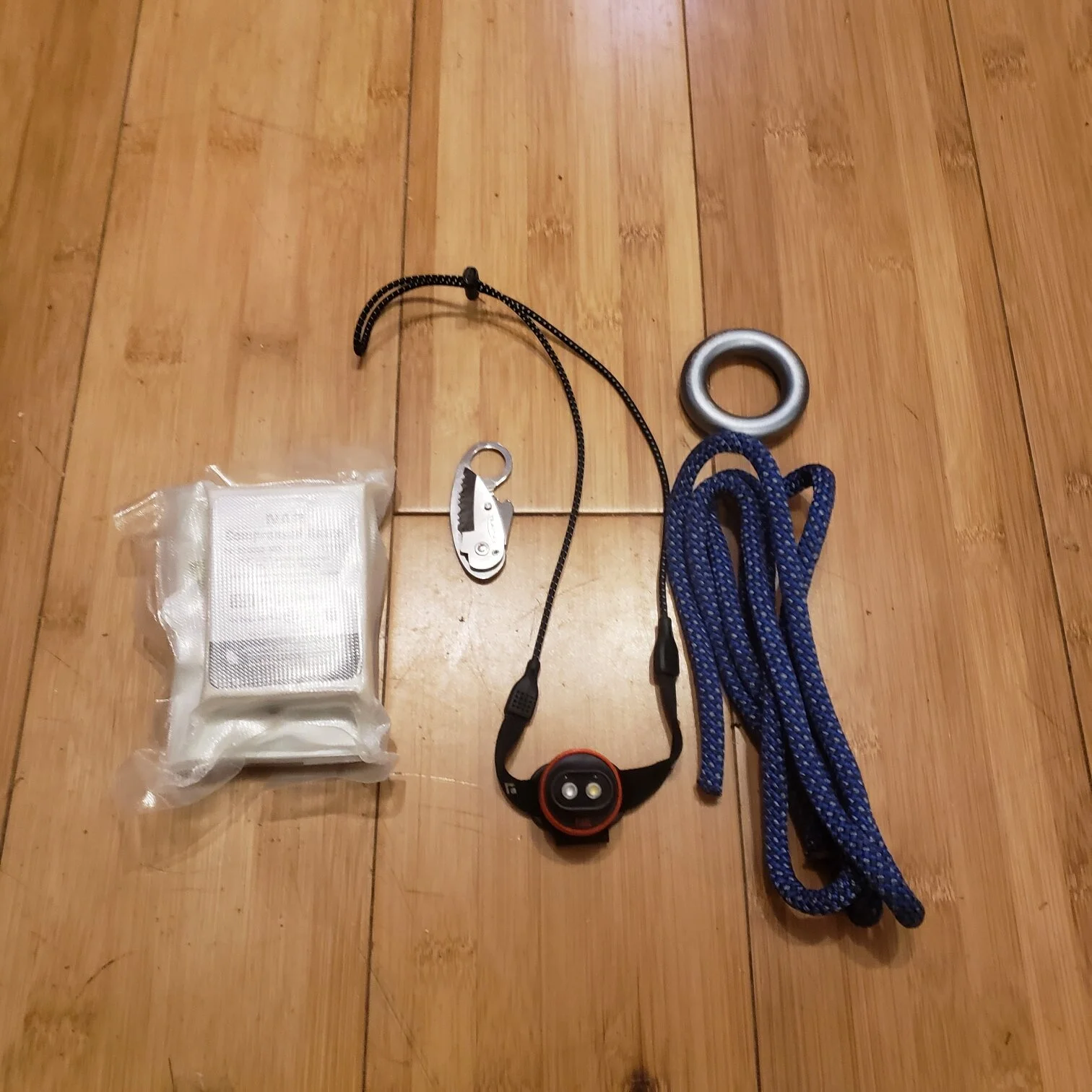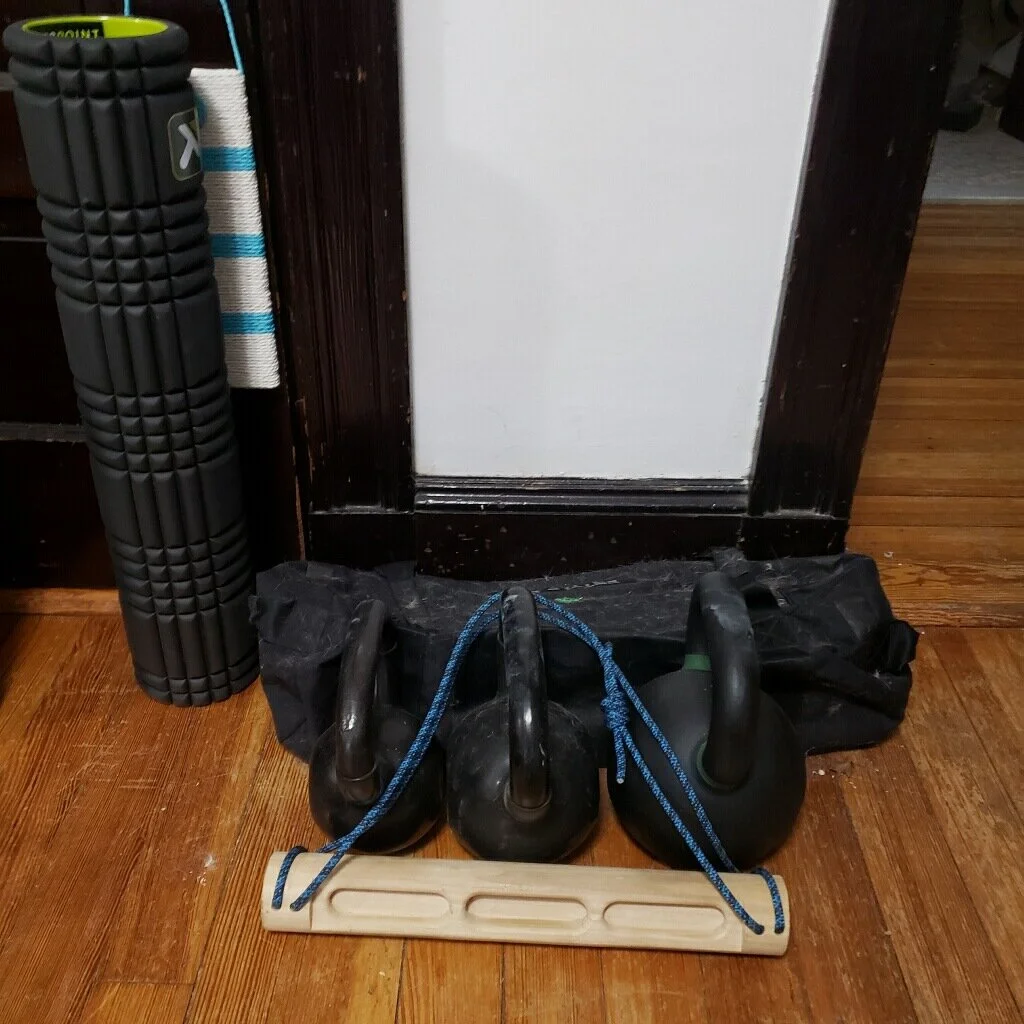Chalk Bags Aren’t Just for Chalk
A chalk bag is a great place to carry emergency essentials when you're climbing. It’s always there, rarely forgotten, and often has room to stash some critical gear. Here’s what I put in mine.
Headlamp
There’s a common saying in the emergency services and the military that “two is one and one is none.” Essentially, if something is important enough that you need it, you should probably have two of them on you. A headlamp is a great example—batteries die, you forget to throw it into your pack, it’s in your other pack, the list goes on. Keeping a small emergency headlamp like the new Black Diamond Flare in your chalk bag means you will always have a headlamp on your person while climbing. It is great if you end up mid-pitch as the sun slips behind the horizon on a fall classic like Endeavour, you’re unexpectedly breaking down an anchor in the dark, or you just need a light to find the “good” headlamp that’s buried in your pack.
Even when cragging it is a good idea to carry a headlamp in your chalk bag. One more pitch in the fall can easily turn into a walk out over uneven ground in diminishing light.
Knife
A small knife is critical on bigger multi-pitch and alpine climbs, but less so at your sport crag, except maybe to prepare lunch. In the alpine, some descent anchors might have many layers of cordage, most of which is trash. Inspect the anchor, use your knife to remove anything unsafe, and leave a safe anchor with your own cordage when possible. This will keep things nice and clean while reducing the possibility of accidents.
A knife is also useful if you need to cut some of your own cordage to leave a bail anchor. By only leaving what you need, you can maximize the cord you have at the next anchor.
The key characteristics of a chalk bag knife are that it is small and designed for cutting rope. I personally carry a Trango Piranha, which is not noticeable in my bag. (Pro Tip: the Piranha includes a bottle opener for post-send beers!)
Rap Ring
In case I ever have to bail off a multi-pitch climb, I also carry a lightweight rappel ring in my chalk bag. The lightweight ones—like the SMC Rigging Ring—aren’t ideal for repeated use, but they're perfect to get a party off a climb.
Having an extra rap ring is also really handy when you run across that old rappel station that’s missing a ring, folks have just rappelled rope on cord without a carabiner, or somebody thought that the rap carabiner was booty. If you have a rap ring in your chalk bag you can set up a safer rappel and move on with your day.
Trauma Kit
My chalk bag first aid kit is critical for dealing with mid-climb emergencies. The primary goal of my kit is to give me a few tools to deal with trauma, as in major bleeding caused by rockfall or a fall along a sharp flake, not little scrapes or minor issues that can wait till we get back to the ground. The chalk bag first aid kit is an especially critical piece of gear on those short multi-pitch climbs—like these Rumney moderates—where I leave my pack at the base of the climb.
My chalk bag trauma kit is pretty simple—medical gloves, a compressed gauze roll, preferably z-folded, and an Esmark bandage. The compressed gauze from places like North American Rescue provides a substantial amount of gauze for a compact package. It is also the nice fluffy stuff that goes a long way in helping stop substantial bleeding. There is also enough in a package to pack and wrap most wounds. (Pro Tip: If you have clotting issues or are on blood thinners like daily aspirin, consider carrying a hemostatic gauze roll instead. A large roll of a full combat gauze will be the same amount of gauze as the z-folded compressed gauze but with the clotting agent as well.)
I use the Esmark bandage to top off the packed and wrapped wound. The Esmark is essentially a small rubber bandage that provides substantial pressure over the gauze. It is awesome for controlling bleeding, enabling us to go hands-free while dealing with things like setting up a rappel to get back to the ground and towards medical care. While the Esmark is smaller and less versatile than a SWAT-T (which could also be used in this role), I prefer the Esmark because it keeps the weight to a minimum while still having enough capability to handle the majority of bleeding issues.
Beyond these trauma-focused items, it is useful to add a small roll of 1/2 inch tape and some packets of Advil to your chalk bag. These are not critical, but very convenient to have readily available while out climbing.
Extra prusik cord
One final piece of gear for your chalk bag—a second prusik cord. While I always have a Sterling HollowBlock on my harness, I keep a regular bit of cheap accessory cord in a prusik loop in my chalk bag. Having a second one readily available makes many rescue systems much more streamlined. It also is cheap insurance in case l drop my HollowBlock while rigging a rappel. This cord should be longer than a normal prusik, about 2x the length, to allow it to be deployed in different configurations or even cut in half to make two prusik loops. Having a long cord like this also opens up some useful techniques such as the Valdotain Tresse hitch.
Another place to store this cord is as a chalk bag belt. This is a useful idea, one I will likely incorporate on larger, more committing climbing. That said, this cord does not replace having a quickly-accessed secondary cord, either in my chalk bag or on my harness.
Snacks
No chalk bag kit is complete without some emergency snacks. In mine, I stash a bar and a couple of gels so that I’ll always have food on my person while climbing. Having some food readily on hand it makes it easy to grab a quick bite while belaying to stay fueled up. Climbers chronically under-fuel while climbing so something small like this might just help you send your proj.
Chalk Bags
Finding a chalk bag that carries all this stuff can be hard. Two of my favorites are the Mammut Alpine Chalkbag and the Ion Chalk Bag Large from Arc’teryx. The Alpine Chalkbag has huge compartments that comfortably carry all this gear along with a small jacket on the bottom. Meanwhile, the Ion, which Doug uses, has a smaller zippered pocket on the bag. That pocket is the perfect place to store your chalk bag first aid kit and these other essentials.
By Scott Powers.
All of the reviews and recommendations on The Whites Room are testing-driven and objective. We only earn money when you click on our affiliate links and purchase products. If you click on a product link on our site and make a purchase, the retailer will contribute a percentage of the sale to help support the fantastic content we are creating on The Whites Room. We appreciate your support!






